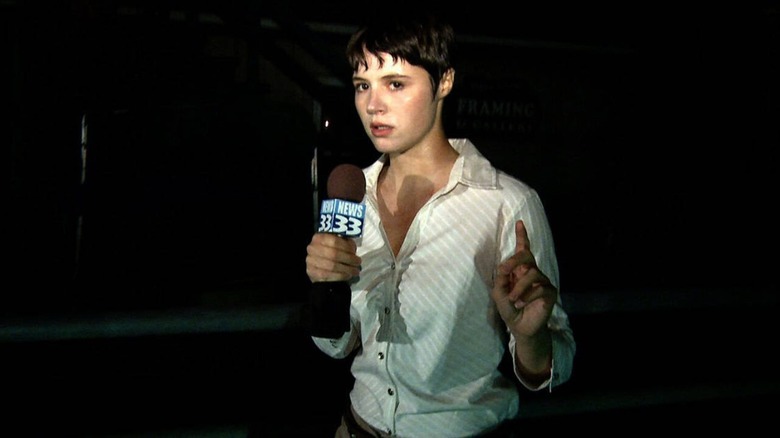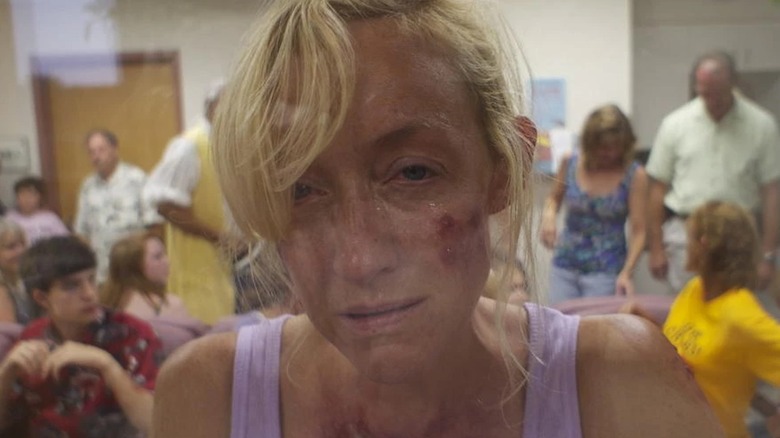Barry Levinson is just not a reputation one would normally affiliate with the horror style. The Academy Award-winning director — finest recognized for “Rain Man,” “Wag the Canine,” and “Diner” — has principally leaned towards satirical comedies or tense drama-thrillers all through his profession. Whereas prepping for a documentary in regards to the air pollution plaguing the Chesapeake Bay in 2012, Levinson determined to forego the venture in favor of a found-footage eco-horror that might combine truth with fiction to disturbing impact. This endeavor was “The Bay,” a mockumentary-style exploration of a contagion premise that feels virtually prescient within the context of our post-pandemic world. Regardless of being the director’s sole foray into horror, Levinson re-invigorates the found-footage subgenre by injecting it with some of the primal fears accompanying a pandemic: the callous cruelty of wilful inaction.
It’s value noting that Levinson integrated the scientific analysis for the deserted Chesapeake documentary into the movie’s narrative framework, and crafted an aura of credibility by taking pictures a bit of the footage with commonly-used digital cameras. In an interview with Mother Jones, Levinson defined how he needed to take an unconventional filmmaking strategy to do justice to the inside workings of the found-footage style:
“We made this movie for $2 million, shot it in 18 days with a small crew utilizing a whole lot of first-time actors, and used 21 several types of video cameras, together with iPhones and low cost underwater video gear, to make it appear credible. This made for extra sophisticated modifying. Every part needed to be plotted out and finished in a single shot.”
The combination of reality-based truth and impressed fiction helped create one thing actually scary, prompting a fragile suspension of disbelief that’s maybe one of many best strengths of “The Bay.” Though not excellent, this ignored horror entry have to be scrutinized for its uncompromising imaginative and prescient, together with its brutality and gruesomeness which convey uncomfortable quasi-real undertones to the floor.
Barry Levinson’s The Bay poses apathy because the true supply of terror
In Levinson’s 2012 movie, journalism intern Donna (Kether Donohue) is assigned to cowl a Fourth of July celebration in Claridge, a quaint little city in Maryland that thrives on its water provide. Bother brews when a neighborhood rooster farm is discovered dumping toxins that find yourself polluting the Chesapeake Bay, and this snowballs into the townsfolk falling sick and exhibiting regarding bodily signs. The Facilities for Illness Management (CDC) is contacted as soon as the state of affairs spirals uncontrolled, however a mixture of apathy and inaction makes issues a lot, a lot worse. Droves of useless fish wash up on the shore, contaminated of us begin dropping useless after writhing in unimaginable ache, and useless birds begin hitting the bloodied streets. Donna and her cameraperson witness these occasions firsthand, torn between documenting the horrors of a real-time catastrophe and sheer helplessness when confronted with the weird signs among the many contaminated.
Not every thing that unfolds on the display feels novel or distinctive, however Levinson is ready to use some well-tread tropes to ramp up rigidity in a state of affairs that comes with no silver lining. Donna’s footage, which is later confiscated by the federal government and subsequently leaked by a 3rd social gathering, is interspersed with frantic Skype calls, cellphone movies, and digital vlogs that seize the visceral nature of an unchecked epidemic. The bodily horrors of pus-filled rashes, violent vomiting, and exploding entrails add to the heightened narrative, with a few mutated creatures thrown in for good measure. Nobody is aware of what to do, and people ready to do one thing, just like the city mayor Stockman (Frank Deal), appear extra mortified by the prospect of Claridge shedding vacationers.
What I recognize about “The Bay” is that it situates ecological horror on the forefront, and exposes our callousness in the direction of the setting even when our transgressions corrupt the sanctity of life. There’s extra to this story than the revulsion it elicits, as we’re compelled to deal with the proof left behind by the numerous mini-vlogs and distressed digital calls that dissect the character of the mutating outbreak. The shameful show of insensitive apathy accompanying this disaster — each throughout and after — is just not fairly, and Levinson intentionally ends “The Bay” on this bitter, discomfiting word.
Barry Levinson is just not a reputation one would normally affiliate with the horror style. The Academy Award-winning director — finest recognized for “Rain Man,” “Wag the Canine,” and “Diner” — has principally leaned towards satirical comedies or tense drama-thrillers all through his profession. Whereas prepping for a documentary in regards to the air pollution plaguing the Chesapeake Bay in 2012, Levinson determined to forego the venture in favor of a found-footage eco-horror that might combine truth with fiction to disturbing impact. This endeavor was “The Bay,” a mockumentary-style exploration of a contagion premise that feels virtually prescient within the context of our post-pandemic world. Regardless of being the director’s sole foray into horror, Levinson re-invigorates the found-footage subgenre by injecting it with some of the primal fears accompanying a pandemic: the callous cruelty of wilful inaction.
It’s value noting that Levinson integrated the scientific analysis for the deserted Chesapeake documentary into the movie’s narrative framework, and crafted an aura of credibility by taking pictures a bit of the footage with commonly-used digital cameras. In an interview with Mother Jones, Levinson defined how he needed to take an unconventional filmmaking strategy to do justice to the inside workings of the found-footage style:
“We made this movie for $2 million, shot it in 18 days with a small crew utilizing a whole lot of first-time actors, and used 21 several types of video cameras, together with iPhones and low cost underwater video gear, to make it appear credible. This made for extra sophisticated modifying. Every part needed to be plotted out and finished in a single shot.”
The combination of reality-based truth and impressed fiction helped create one thing actually scary, prompting a fragile suspension of disbelief that’s maybe one of many best strengths of “The Bay.” Though not excellent, this ignored horror entry have to be scrutinized for its uncompromising imaginative and prescient, together with its brutality and gruesomeness which convey uncomfortable quasi-real undertones to the floor.
Barry Levinson’s The Bay poses apathy because the true supply of terror
In Levinson’s 2012 movie, journalism intern Donna (Kether Donohue) is assigned to cowl a Fourth of July celebration in Claridge, a quaint little city in Maryland that thrives on its water provide. Bother brews when a neighborhood rooster farm is discovered dumping toxins that find yourself polluting the Chesapeake Bay, and this snowballs into the townsfolk falling sick and exhibiting regarding bodily signs. The Facilities for Illness Management (CDC) is contacted as soon as the state of affairs spirals uncontrolled, however a mixture of apathy and inaction makes issues a lot, a lot worse. Droves of useless fish wash up on the shore, contaminated of us begin dropping useless after writhing in unimaginable ache, and useless birds begin hitting the bloodied streets. Donna and her cameraperson witness these occasions firsthand, torn between documenting the horrors of a real-time catastrophe and sheer helplessness when confronted with the weird signs among the many contaminated.
Not every thing that unfolds on the display feels novel or distinctive, however Levinson is ready to use some well-tread tropes to ramp up rigidity in a state of affairs that comes with no silver lining. Donna’s footage, which is later confiscated by the federal government and subsequently leaked by a 3rd social gathering, is interspersed with frantic Skype calls, cellphone movies, and digital vlogs that seize the visceral nature of an unchecked epidemic. The bodily horrors of pus-filled rashes, violent vomiting, and exploding entrails add to the heightened narrative, with a few mutated creatures thrown in for good measure. Nobody is aware of what to do, and people ready to do one thing, just like the city mayor Stockman (Frank Deal), appear extra mortified by the prospect of Claridge shedding vacationers.
What I recognize about “The Bay” is that it situates ecological horror on the forefront, and exposes our callousness in the direction of the setting even when our transgressions corrupt the sanctity of life. There’s extra to this story than the revulsion it elicits, as we’re compelled to deal with the proof left behind by the numerous mini-vlogs and distressed digital calls that dissect the character of the mutating outbreak. The shameful show of insensitive apathy accompanying this disaster — each throughout and after — is just not fairly, and Levinson intentionally ends “The Bay” on this bitter, discomfiting word.




















